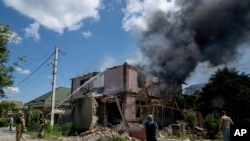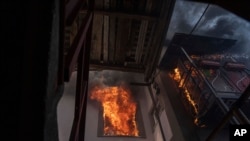Latest developments:
- The United States is confident Ukraine’s counteroffensive against Russia is making progress despite the lack of any significant break in the Russian lines. Joint Chiefs of Staff Chairman General Mark Milley told an audience in Washington Friday the slow pace of Ukraine’s advance is “part of the nature of war.”
- Milley also said the U.S. is openly considering providing Ukraine with cluster-munitions, long-range Army Tactical Missile System (ATACMS) missiles and even some of its own F-16 fighter jets. "These things are on the table,” he said. “There's no decision at this point.”
- The U.N. expressed concern Friday that no new ships have been registered since June 26 under a deal allowing the safe Black Sea export of grain from Ukraine. "We call on the parties to commit to the continuation and effective implementation of the agreement without further delay," U.N. spokesperson Farhan Haq told reporters.
- Russian President Vladimir Putin spoke by phone with Indian Prime Minister Narendra Modi on Friday. Moscow said Modi expressed support for what the Kremlin called the Russian leadership's decisive actions in handling the mutiny by the Wagner mercenary group last Saturday. The call comes after the U.S. and India declared themselves "among the closest partners in the world" last week during a state visit to Washington by Modi. India has yet to condemn ally Russia for the invasion of Ukraine.
- Russian forces hit a school in Serhiivka, Donetsk oblast, Friday, killing two members of staff and injuring six others, the regional prosecutor's office reported.
Russian shelling has killed three people and injured 17 others in Ukraine’s southern and eastern regions, Ukrainian officials reported Saturday morning. The civilian casualties come as Spanish Prime Minister Pedro Sanchez visits Kyiv in a show of support.
Three people died and 10 more suffered wounds Friday in the front-line eastern Donetsk region, where fierce battles are raging, Gov. Pavlo Kyrylenko said Saturday.
The Ukrainian General Staff says intense battles were ongoing in three areas in Donetsk where it cited large numbers of Russian troops attempting to take territory. Authorities on social media said the perimeters of Bakhmut, Lyman and Marinka are seeing clashes, and that Russia had tried unsuccessfully Friday to advance there.
Five people, including a child, were wounded Friday and overnight in the Kherson region in the south, according to Gov. Oleksandr Prokudin. He reported that Russian forces launched 82 artillery, drone, mortar shell and rocket strikes on the province, which is divided by a stretch of the 1,500-kilometer front line and still recovering from flooding unleashed in June by the collapse of the Kakhovka Dam.
In the northeastern Kharkiv region, Russian shelling Friday wounded a 57-year-old civilian man, local Gov. Oleh Syniehubov said. In the Sumy region farther west, a teenage boy was hurt in a strike from across the Russian border, the local military administration reported.
As the fighting rages and Ukraine’s counteroffensive continues, Sanchez, whose country currently holds the European Union presidency, is underscoring the EU’s unwavering backing as Ukraine’s leader has complained about the slow delivery of Western weapons.
Sanchez is reassuring Ukraine it has the support of the European Union. The Spanish prime minister posted on Twitter, “We will keep supporting the Ukrainian people until peace returns to Europe.”
Amid this backdrop, it has been learned that CIA Director William Burns made a visit to Ukraine in June. Burns met with Ukrainian President Volodymyr Zelenskyy and intelligence officials to discuss Ukraine’s counteroffensive strategy. Reports of the meetings emerged Friday.
The clandestine discussions are reported to have occurred before Russian mercenary leader Yevgeniy Prigozhin’s thwarted rebellion against Russian President Vladimir Putin and the Russian defense establishment.
Burns reportedly called Russian intelligence chief Sergei Naryshkin this week to assure the Kremlin the United States was not involved in last week’s aborted mutiny by the Wagner Group’s Yevgeny Prigozhin.
The slow pace of Ukraine’s counteroffensive against Russian troops is not causing any panic among top U.S. military officials.
Ukrainian officials have expressed frustration in recent days, calling on Washington and the West to provide it more advanced weaponry to help dent Russian defensive positions and allow Ukrainian troops to retake more territory.
U.S. officials say they remain confident, though, that Ukraine’s counteroffensive will make headway, even if it takes six to eight weeks before Ukrainian forces see more substantial gains.
"War on paper and real war are different,” the top U.S. military commander, Joint Chiefs of Staff Chairman General Mark Milley, told an audience in Washington Friday.
"That it's going slower than people predicted doesn't surprise me at all," Milley said during an appearance at the National Press Club, saying Ukrainian forces are “advancing, steadily, deliberately."
“It’s going to be very difficult. It’s going to be very long. And it’s going to be very, very bloody and no one should have any illusions about any of that,” he said.
Earlier Friday, Ukraine’s top general told The Washington Post his forces are in desperate need of ammunition and other advanced weaponry.
It “pisses me off,” said Commander-in-Chief of the Armed Forces of Ukraine Valery Zaluzhny. “This is not a show … It's not a show the whole world is watching and betting on or anything. Every day, every meter is given by blood.”
“Without being fully supplied, these plans are not feasible at all,” he added, criticizing the West for pushing war plans that rely on air superiority, which neither Ukraine nor Russia have been able to establish.
Zaluzhny and other Ukrainian officials have repeatedly called on the U.S. and its other allies to provide not just tanks and armored vehicles, but cluster munitions, long-range missiles, and modern fighter jets, such as F-16s.
So far, the U.S. has been hesitant to provide Kyiv with such systems, although it has said it will allow its allies to provide Ukraine with the U.S.-made jets and is training its pilots to fly them. Washington says the focus has been on giving Ukraine systems and weapons it can immediately deploy to the front lines.
Milley said Kyiv’s requests were not being ignored.
"ATACMS, F-16s or anything else is in a constant review process," Milley said. "These things are on the table. There's no decision at this point."
Milley said the U.S, has also not ruled out providing Ukraine with cluster munitions, despite concerns by some allies about the nature of the bombs.
The munitions, which open in midair and drop bomblets, are opposed by a number of humanitarian groups, which say they have a high rate of failure and often lead to civilian casualties.
Ukrainian Defense Minister Oleksii Reznikov has said Kyiv’s forces have successfully liberated nine settlements in Donetsk and Zaporizhzhia oblasts, though the main attack is yet to come.
Northern border
Zelenskyy has asked his senior military leadership to strengthen Ukraine’s northern military sector after the arrival in Belarus of Russian mercenary leader Prigozhin.
"The decision … is for Commander-in-Chief Zaluzhny and 'North' commander [General Serhiy] Naev to implement a set of measures to strengthen this direction," Zelenskyy said on the Telegram messaging app.
White House national security spokesman John Kirby told VOA the U.S. will “continue to monitor Wagner's activities wherever they are around the world, and we're going to continue to hold them properly accountable for the kinds of egregious violent, deadly and illegal conduct ... that they are still capable of conducting.”
After pushing Russian forces out of northern regions last year, Ukraine took steps to tighten the defense of its border with Belarus, a close ally of Russia.
VOA White House Bureau Chief Patsy Widakuswara contributed to this report. Some information for this story came from The Associated Press, Agence France-Presse and Reuters.

























